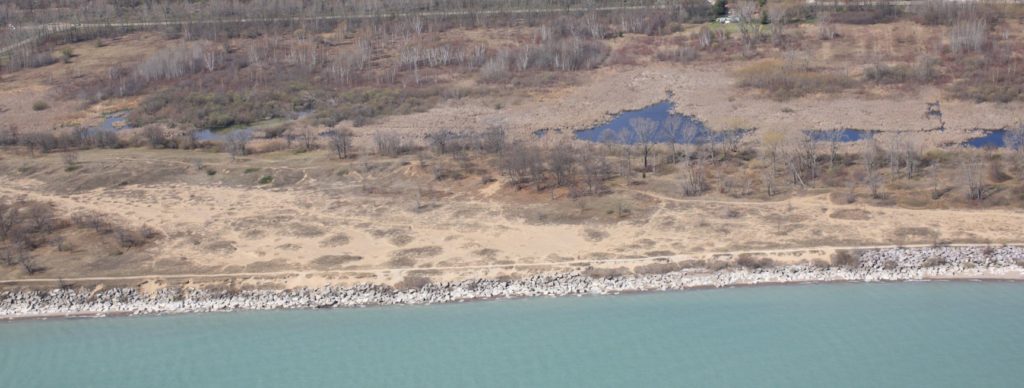Designing Innovative Natural Infrastructure to Protect Kenosha Dunes
Restoring Ecological Health and Aquatic Biodiversity (REHAB) in Southeastern Wisconsin’s Lake Michigan Coast
This project is facilitating innovative natural infrastructure approaches for Restoring Ecological Health and Aquatic Biodiversity (REHAB) of degraded dune and beach systems in southeastern Wisconsin. The primary focus is on the Kenosha Dunes complex at Chiwaukee Prairie State Natural Area, where rapid erosion is threatening this unique dune ecosystem. These nature-based design concepts could be applied to similar sites to enhance coastal community resilience and fish and wildlife habitat throughout Southeastern Wisconsin’s Lake Michigan coast.

Kenosha Dunes – A Rare Ecosystem
Kenosha Dunes is a rare Great Lakes dunes ecosystem located within the Chiwaukee Prairie State Natural Area along the Lake Michigan Shoreline in Kenosha County, Wisconsin. The site provides habitat or refuge for more than 400 species of vascular plants, including 26 rare, threatened or endangered species. Five of the most endangered natural community types of the Midwest are found within the State Natural Area. As a whole, the Chiwaukee Prairie State Natural Area is recognized as a Conservation Opportunity Area of global significance by the Wisconsin Wildlife Action Plan and a Wetland of International Importance by the Ramsar Convention. Kenosha Dunes is a popular recreation area where users can experience these unique ecosystems and Lake Michigan.
Coastal Erosion Issues
Kenosha Dunes has experienced severe erosion in recent years that has resulted in the loss of up to 25 feet per year of the dunes since 2014. While coastal erosion is an ongoing natural process, since 2014 a number of large storms have created extreme waves that, combined with above average water levels on the lake, have battered the shoreline. Kenosha Dunes was protected by a degraded revetment (see 2012 photo below) that has been significantly damaged by these storms and no longer provides protection to the coast. As a result, Kenosha Dunes has been eroding at a rate as high as 25 feet per year for the past 4 years (see 2018 photo below). With Lake Michigan water levels projected to remain above average for the foreseeable future, this rapid erosion is expected to continue without any intervention.
Slide to compare 2012 and 2018 erosion and water level conditions at Kenosha Dunes
A webcam at the site has been capturing the ongoing erosion since October 2019. The camera had to be moved in January 2020 due to continued erosion. You can see a comparison of our first image at the new location with the most recent image below. All webcam images are accessible at https://infos.cee.wisc.edu/Kenosha/kenosha_dunes.html
Slide to compare February 2020 conditions with today
An Innovative Natural Infrastructure Approach to REHAB Kenosha Dunes
This project will design nature-based shoreline to protect the dunes from future erosion and improve coastal and marine habitats. The concept behind this design is to reduce the amount of wave energy that impacts the coast to allow potential locations for marine habitat while the protected coast can support beach and dune habitat. More updates on the design at Kenosha Dunes will be available as the project develops.
Regional Benefits
The project will also identify nearby beaches where a similar approach may be a suitable method to manage shoreline erosion while providing habitat connectivity benefits.
In The News
Project in the Works to Save the Kenosha Dunes – Kenosha News, 2/8/2020 – https://www.kenoshanews.com/news/local/project-in-the-works-to-save-the-kenosha-dunes/article_bf493e22-d751-552f-8dbf-c66856660756.html
Impressive Effort to Save the Kenosha Dunes Faces Deadline, Merits Funding – Kenosha News, 2/21/2020 – https://www.kenoshanews.com/opinion/editorial/our-view-impressive-effort-to-save-the-kenosha-dunes-faces/article_61164feb-a288-5e77-97aa-d765ace41e20.html
Partners
Natural Resources Foundation of Wisconsin
Wisconsin Department of Natural Resources
University of Wisconsin-Madison Civil and Environmental Engineering Coastal Sustainability Lab
University of Wisconsin Sea Grant Institute
University of Wisconsin-Milwaukee School of Freshwater Sciences
Wisconsin Coastal Management Program
RED BARN Design and Engineering, S.C.
Geo-Professional Consultants, LLC
The Nature Conservancy
United States Army Corps of Engineers
United States Environmental Protection Agency
Funding
This project is made possible due to support from:
The Fund for Lake Michigan
National Fish and Wildlife Foundation – National Coastal Resilience Fund






